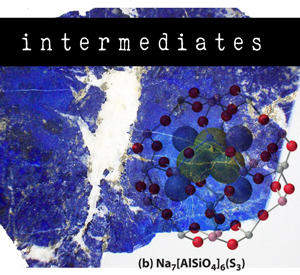

Hemimorphite forms as crystals or rounded aggregates and is usually colorless or white. It is uncommon as a jewelry component, but when found in sky-blue color, it can be striking. The English county of Derbyshire (a favorite of Agatha Christie) is a classic locality for hemimorphite.
The mineral lazurite is the main component of lapis lazuli and responsible for its deep blue color. Lapis lazuli also contains pyrite and calcite and sometimes sodalite. Afghanistan is well known for high quality lapis, which is intense dark blue with minor patches of white (sodalite) and gold flecks (pyrite). It's been an ornamental gemstone for centuries; Egyptian King Tutankhamun's funeral mask has inlays of lapis lazuli and it was a popular stone for scarabs as well. It formed the background for the Standard of Ur, an a detailed Sumerian mosaic found by the Woolleys in southern Iraq. Today it remains just as popular in jewelry and decorative items as it was in antiquity.
Serpentine is named in allusion to its mottled appearance, like snakeskin, but it can be translucent and uniform like "new jade", the trade name given to an apple-green variety of serpentine. Serpentine is a secondary mineral, resulting from chemical changes to existing minerals. It shares the basic chemical formula Si2O5 with other phyllosilicates, which leads to perfect cleavage that tends not to be visible until the stone is broken!
Sodalite is named due to its high sodium content. It typically forms in silica-poor igneous rocks and sometimes found in volcanic ejecta or metamorphosed limestones. It's principally used as a gemstone, and its deep blue color often leads it to be mistaken for lapis. Indeed, it is sometimes found in lapis as a pale matrix.